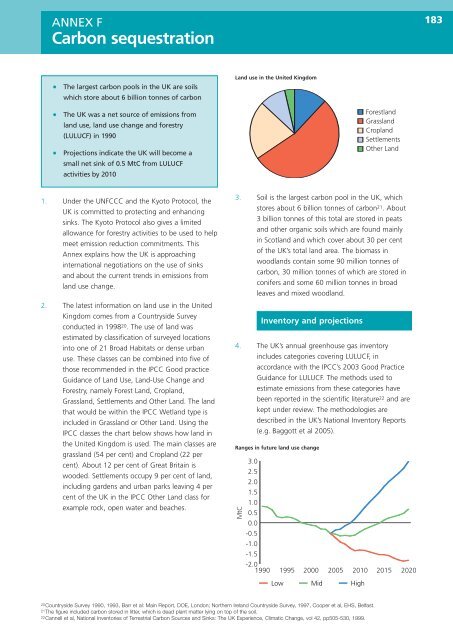UK Climate Change Programme 2006 - JNCC - Defra
UK Climate Change Programme 2006 - JNCC - Defra
UK Climate Change Programme 2006 - JNCC - Defra
You also want an ePaper? Increase the reach of your titles
YUMPU automatically turns print PDFs into web optimized ePapers that Google loves.
ANNEX F<br />
Carbon sequestration<br />
183<br />
• The largest carbon pools in the <strong>UK</strong> are soils<br />
which store about 6 billion tonnes of carbon<br />
Land use in the United Kingdom<br />
• The <strong>UK</strong> was a net source of emissions from<br />
land use, land use change and forestry<br />
(LULUCF) in 1990<br />
• Projections indicate the <strong>UK</strong> will become a<br />
small net sink of 0.5 MtC from LULUCF<br />
activities by 2010<br />
Forestland<br />
Grassland<br />
Cropland<br />
Settlements<br />
Other Land<br />
1. Under the UNFCCC and the Kyoto Protocol, the<br />
<strong>UK</strong> is committed to protecting and enhancing<br />
sinks. The Kyoto Protocol also gives a limited<br />
allowance for forestry activities to be used to help<br />
meet emission reduction commitments. This<br />
Annex explains how the <strong>UK</strong> is approaching<br />
international negotiations on the use of sinks<br />
and about the current trends in emissions from<br />
land use change.<br />
2. The latest information on land use in the United<br />
Kingdom comes from a Countryside Survey<br />
conducted in 1998 20 . The use of land was<br />
estimated by classification of surveyed locations<br />
into one of 21 Broad Habitats or dense urban<br />
use. These classes can be combined into five of<br />
those recommended in the IPCC Good practice<br />
Guidance of Land Use, Land-Use <strong>Change</strong> and<br />
Forestry, namely Forest Land, Cropland,<br />
Grassland, Settlements and Other Land. The land<br />
that would be within the IPCC Wetland type is<br />
included in Grassland or Other Land. Using the<br />
IPCC classes the chart below shows how land in<br />
the United Kingdom is used. The main classes are<br />
grassland (54 per cent) and Cropland (22 per<br />
cent). About 12 per cent of Great Britain is<br />
wooded. Settlements occupy 9 per cent of land,<br />
including gardens and urban parks leaving 4 per<br />
cent of the <strong>UK</strong> in the IPCC Other Land class for<br />
example rock, open water and beaches.<br />
3. Soil is the largest carbon pool in the <strong>UK</strong>, which<br />
stores about 6 billion tonnes of carbon 21 . About<br />
3 billion tonnes of this total are stored in peats<br />
and other organic soils which are found mainly<br />
in Scotland and which cover about 30 per cent<br />
of the <strong>UK</strong>’s total land area. The biomass in<br />
woodlands contain some 90 million tonnes of<br />
carbon, 30 million tonnes of which are stored in<br />
conifers and some 60 million tonnes in broad<br />
leaves and mixed woodland.<br />
Inventory and projections<br />
4. The <strong>UK</strong>’s annual greenhouse gas inventory<br />
includes categories covering LULUCF, in<br />
accordance with the IPCC’s 2003 Good Practice<br />
Guidance for LULUCF. The methods used to<br />
estimate emissions from these categories have<br />
been reported in the scientific literature 22 and are<br />
kept under review. The methodologies are<br />
described in the <strong>UK</strong>’s National Inventory Reports<br />
(e.g. Baggott et al 2005).<br />
Ranges in future land use change<br />
MtC<br />
3.0<br />
2.5<br />
2.0<br />
1.5<br />
1.0<br />
0.5<br />
0.0<br />
-0.5<br />
-1.0<br />
-1.5<br />
-2.0<br />
1990 1995 2000<br />
Low Mid High<br />
2005 2010 2015 2020<br />
20Countryside Survey 1990, 1993, Barr et al: Main Report, DOE, London; Northern Ireland Countryside Survey, 1997, Cooper et al, EHS, Belfast.<br />
21The figure included carbon stored in litter, which is dead plant matter lying on top of the soil.<br />
22Cannell et al, National Inventories of Terrestrial Carbon Sources and Sinks: The <strong>UK</strong> Experience, Climatic <strong>Change</strong>, vol 42, pp505-530, 1999.
















